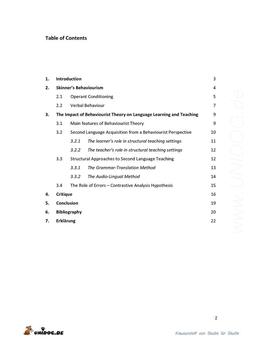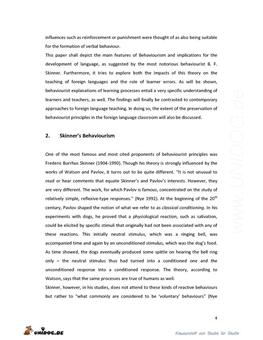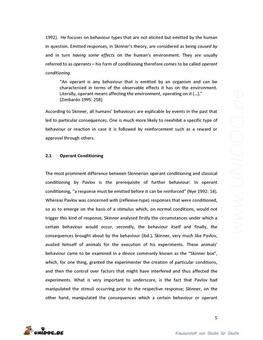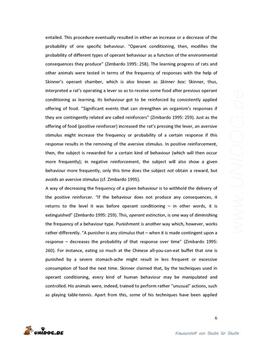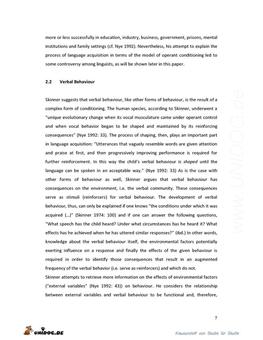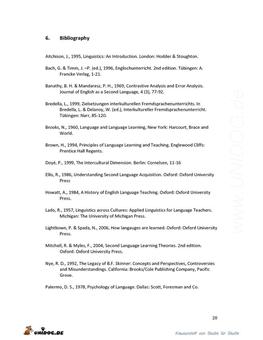| Dokumente | |
|
|
Dokumentvorschau |
Behaviourism and its Implications for Second Language Teachi |
Dokument-Nr.: F-AATJ |


|
|
Dokument-DownloadUm Zugriff auf dieses Dokument zu erhalten, musst Du Mitglied der UNIDOG Community sein. |
|
Inhalt / Beschreibung
Table of Contents 1. Introduction 2. Skinner’s Behaviourism 2.1 Operant Conditioning 2.2 Verbal Behaviour 3. The Impact of Behaviourist Theory on Language Learning and Teaching 3.1 Main features of Behaviourist Theory 3.2 Second Language Acquisition from a Behaviourist Perspective 3.2.1 The learner’s role in structural teaching settings 3.2.2 The teacher’s role in structural teaching settings 3.3 Structural Approaches to Second Language Teaching 3.3.1 The Grammar-Translation Method 3.3.2 The Audio-Lingual Method 3.4 The Role of Errors – Contrastive Analysis Hypothesis 4. Critique 5. Conclusion 6. Bibliography 7. Erklärung 1. Introduction When the United States of America entered into World War II, the American Army eagerly sought ways of how to successfully supply their military personnel with sufficient conversational proficiency in a variety of foreign languages such as German, French, Italian or Chinese. The first foreign language programs were developed by linguists of several universities, one of which was the most renowned structural linguist Leonard Bloomfield. He applied drill methods that, on account of their intensity, proved to be most efficient as for the time needed to endow learners with basic conversational routines. Learners got in touch with a native speaker whom they were encouraged to interact with in guided conversation. They thus gradually learned how to communicate within the foreign language. From this time onwards, linguists and applied linguists were trying to further develop the methods of teaching of English as a foreign language. They, in so doing, were mostly influenced by structural theories, according to which language is but a system of related elements and equally teachable to all learners. Behaviourism turned out to be the predominant psychological theory. One of the earliest proponents of this theory, apart from Ivan Pavlov, was the American psychologist John B. Watson. He insisted that psychology be not concerned with human mind but rather with human behaviour. Needless to say, behaviourism made its entrance into the foreign language classroom, as well. As a consequence out of the lacking interest in processes of the human mind, all learners were regarded as being equal as to the teachability of particular contents. What, then, needed to be specialized in was all the more the teaching methods. These methods appeared to be elaborated within Behaviourist Theory, as it claimed to be a learning theory. In terms of foreign language teaching, teachers and applied linguists further agreed upon methods that did not care so much about internal mental processes but rather on external factors that contribute their respective parts to language learning or, in behaviourist speaking, to habit formation. Thus, accurate input and frequent exposure to native speaker-like language items were considered most effective and successful as for enabling learners to fully master the target language. Moreover, external influences such as reinforcement or punishment were thought of as also being suitable for the formation of verbal behaviour. This paper shall depict the main features of Behaviourism and implications for the development of language, as suggested by the most notorious behaviourist B. F. Skinner. Furthermore, it tries to explore both the impacts of this theory on the teaching of foreign languages and the role of learner errors. As will be shown, behaviourist explanations of learning processes entail a very specific understanding of learners and teachers, as well. The findings will finally be contrasted to contemporary approaches to foreign language teaching. In doing so, the extent of the preservation of behaviourist principles in the foreign language classroom will also be discussed. |
|
Vorschau-Ausschnitte
|
|||||||
